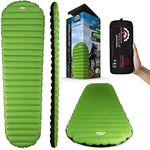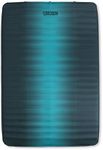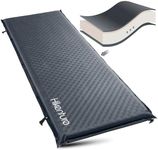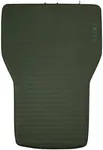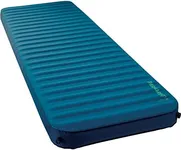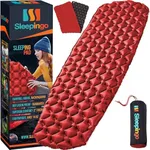Buying Guide for the Best Camping Mattresses
Choosing the right camping mattress can make a huge difference in how well you sleep outdoors. The best mattress for you depends on your camping style, how you plan to carry it, and your comfort preferences. Think about whether you'll be backpacking or car camping, the climate you'll be in, and how much space you have in your tent. Understanding the key features will help you find a mattress that keeps you comfortable and well-rested during your adventures.Type (Foam, Air, Self-Inflating)The type of camping mattress refers to how it is constructed and how it provides cushioning. Foam mattresses are simple, durable, and provide insulation even if they get wet, but they can be bulky. Air mattresses are lightweight and pack down small, but require inflation and can be punctured. Self-inflating mattresses combine foam and air, offering a balance of comfort, insulation, and convenience. If you need something light and compact for backpacking, air or self-inflating types are best. For car camping or if weight isn’t a concern, foam or thicker self-inflating mattresses offer more comfort.
ThicknessThickness measures how tall the mattress is when inflated or unrolled, and it affects both comfort and insulation. Thin mattresses (under 1 inch) are lightweight and packable but may not cushion you from hard or uneven ground. Medium thickness (1-2.5 inches) offers a balance between comfort and portability. Thick mattresses (over 2.5 inches) provide the most comfort, especially for side sleepers or those who want a bed-like feel, but they are bulkier. Choose thickness based on how much comfort you need versus how much weight and space you can carry.
R-Value (Insulation)R-Value is a measure of how well the mattress insulates you from the cold ground. A low R-value (under 2) is suitable for warm weather camping. Medium R-values (2-4) work for three-season use, while high R-values (over 4) are best for cold weather or winter camping. If you camp in colder conditions or get cold easily, look for a higher R-value. For summer camping, a lower R-value is usually enough.
Packed Size and WeightPacked size and weight describe how small and light the mattress is when stored. Smaller and lighter mattresses are easier to carry, making them ideal for backpacking. Larger and heavier mattresses are fine for car camping where you don’t have to carry your gear far. Think about how you’ll transport your mattress and how much space you have in your backpack or car to decide what’s best for you.
Durability and MaterialDurability depends on the materials used and how the mattress is constructed. Thicker fabrics and reinforced seams make a mattress more resistant to punctures and wear, which is important if you camp on rough ground or use the mattress often. Softer top materials can add comfort but may be less durable. If you camp in rugged areas or want a long-lasting mattress, look for tough materials. For occasional use on soft ground, lighter materials may be fine.
Ease of Inflation/DeflationThis refers to how quickly and easily you can set up or pack away the mattress. Some mattresses require manual inflation with your breath or a pump, while self-inflating models expand on their own and just need a few extra breaths. Quick and easy inflation is helpful if you want to save time or energy at camp. If you don’t mind spending a few minutes inflating, a manual air mattress can be fine. For convenience, self-inflating options are great.
